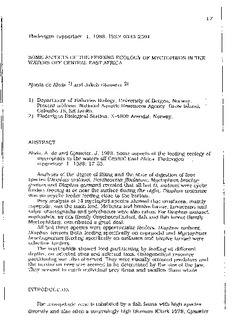| dc.description.abstract | Analyses of the degree of filling and the state of digestion of four
species (Diaphus watasei, Benthosema fibulatum, Myctophum brachygnatum
and Diaphus garmani) revealed that all but D. watasei were cyclic
feeders feeding at or near the surface during the night. Diaphus watasei
was an acyclic feeder feeding close to the bottom.
Prey analysis of 14 myctophid species showed that crustacea, mainly
copepods, was the main food. Molluscs and bivalve larvae, larvaceans and
salps, chaetognaths and polychaetes were also eaten. For Diaphus watasei,
euphasiids, squids (family Onychoteuthidae), fish and fish larvae (family
Myctophidae), contributed a great deal.
All but three species were opportunistic feeders. Diaphus nielseni,
Diaphus jenseni (both feeding specifically on copepods) and Myctophum
brachygriatum (feeding specifically on molluscs and bivalve larvae) were
selective feeders.
The myctophids showed food partitioning by feeding at different
depths, on selected sizes and selected taxa. Ontogenetical resource
partitioning was also observed. They were visually oriented predators and
the maximum prey size seemed to be determined by the size of the jaw.
They seemed to catch individual prey items and swallow them whole. | en |
